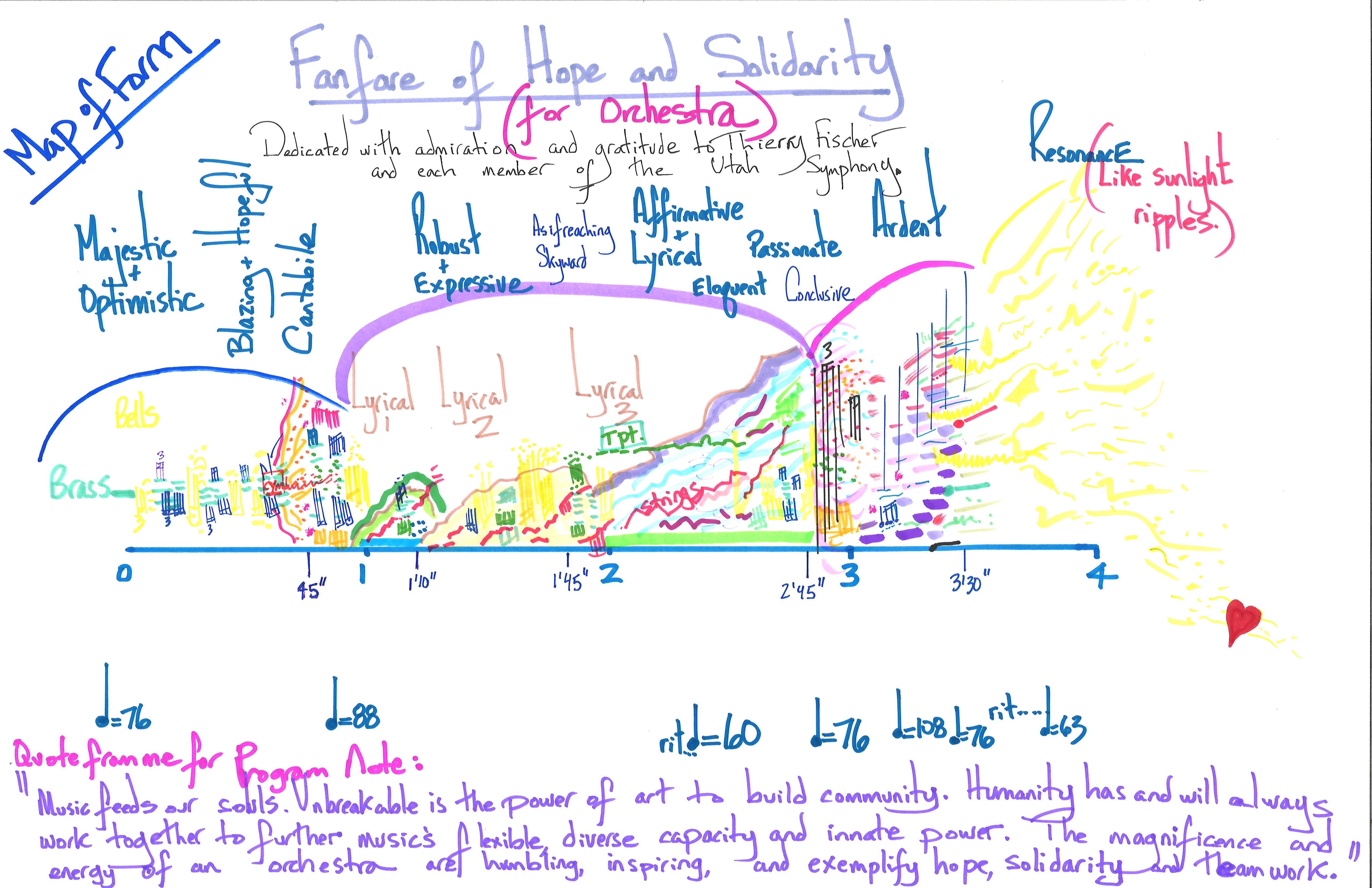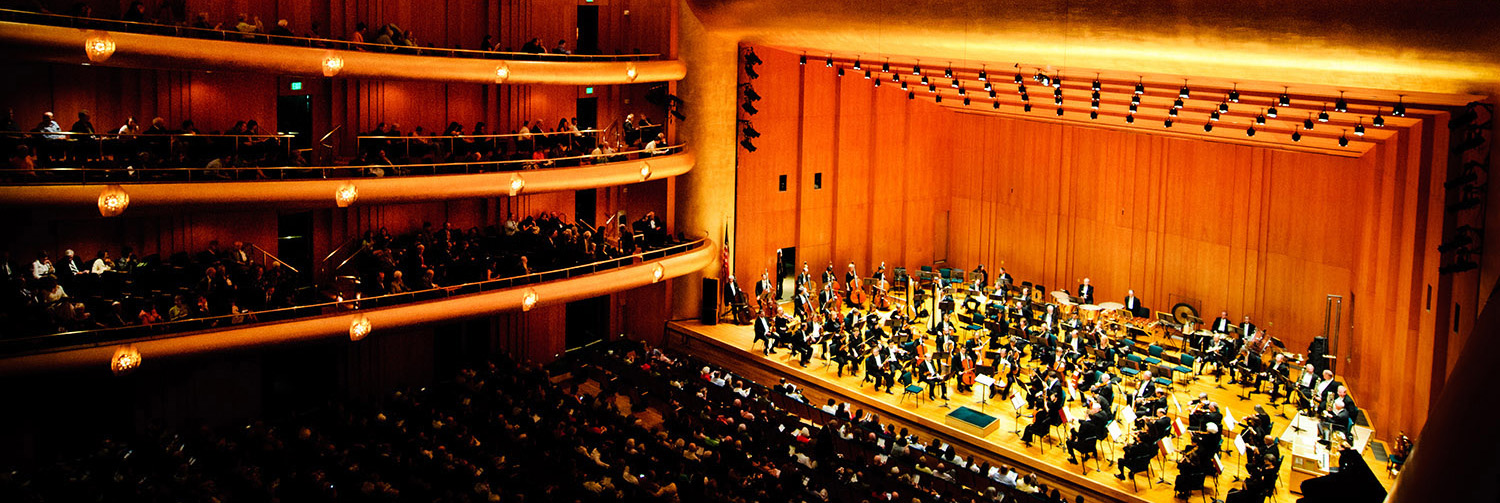For 21CA21/4220/3 or 2 perc. (very few percussion instruments) strings
Premiered on YouTube, during a period of mandatory social distancing, on Memorial Day Weekend, by the Utah Symphony, Thierry Fischer, conducting, 22 May 2020
First premiered for a live audience by the University of South Carolina Symphony Orchestra conducted by Scott Weiss on 21 September 2021.
Chicago Premiere given by the Chicago Symphony Orchestra conducted by Andres Grams on 18 November 2022 at Symphony Center in Chicago.
Duration: 4 minutes
Dedicated with admiration and gratitude to Thierry Fischer and each member of the Utah Symphony.
Memorial Day Weekend and Fourth of July festivities are perfect times to perform this Fanfare.
Performing this with musicians surrounding the audience works marvelously since the individual parts are not technically challenging.
“I believe music feeds our souls. Unbreakable is the power of art to build community. Humanity has and will always work together to further music’s flexible, diverse capacity and innate power. The magnificence and energy of massed musical resources, such as an orchestra, are humbling, inspiring, and exemplify hope, solidarity and teamwork.” — Augusta Read Thomas
Fanfare of Hope and Solidarity - WORLD PREMIERE
Thierry Fischer, conductor; Utah Symphony
Music director, Thierry Fischer called Augusta to invite her to create a new, four-minute fanfare that could be performed by the Utah Symphony, with the stipulation that each musician would be performing alone from their homes. Fanfare of Hope and Solidarity was composed in late April and early May 2020 and it was a mere two weeks from that phone call until the time that Augusta delivered a full orchestral score and set up orchestral parts. (Clearly Augusta and her engraver had very little sleep that fortnight!) Certain limitations exist simply due to the nature of how the music will be premiered. As one example, Augusta was only able to write for a very few, small percussion instruments which happened to be stored in the homes of the percussionists. The composition, which features the brass section of the Utah Symphony, is majestic, optimistic, blazing, and passionate, yet, in the center of the piece, a robust expressive an eloquent lyrical passage unfolds a range of emotions. The composition ends as if reaching skyward - affirming and hopeful – as bells’ resonance hangs in the air like sunlight ripples.

"Composing music is such a deeply spiritual, all-encompassing, profoundly humbling life adventure," Thomas says. "I see things more cosmically—and humanity, and the power of music, the gorgeousness of 80 players together? It's such a beautiful metaphor."
Scott Renshaw Isaacs, Salt Lake City Weekly
Like virtually every other category in the performing arts, symphonies have been impacted by the coronavirus pandemic, with live performances canceled and a need to think creatively about how to remain connected to audiences. For many symphonies around the country, the simplest answer has been to find ways of playing previously recorded-performances, or perhaps pull together musicians from their homes for smaller-scale live-stream performances. Maestro Thierry Fischer and the Utah Symphony took one of the more counterintuitive approaches possible: What about soliciting and performing brand-new works for full orchestra?
On May 22, Utah Symphony released such a new work with a socially distanced performance of American composer Augusta Read Thomas' Fanfare of Hope and Solidarity via the Symphony's YouTube channel (youtube channel) and Facebook page (facebook.com/utahsymphony). This was followed on May 30 with the release of London-based composer Dai Fujikura's Longing From Afar. "The world has momentarily stopped. Our desire for creativity is multiplied," said Fischer, in a press release accompanying the release of Fanfare of Hope and Solidarity. "New music is a call to look, listen and guess what is rarely said."
Thomas—who previously provided new work for Utah Symphony with Terpsichore's Dream in 2001 and Eos in 2015—spoke by phone from her home in Chicago, recalling that her workaholic tendencies might have been one of the reasons she was the right fit for Fischer's interest in getting new work out into the world. "I'm an obsessive composer. I love to write, and write long days," Thomas says. "[Fischer] was like, 'Gusty, can you compose a piece quickly?' 'How quickly?' 'Two weeks!'"
Fischer and Thomas agreed that the piece should be a work for full orchestra—not merely a work for a quartet, quintet or other smaller group. And they addressed the idea that a 2-1/2 to 4-minute fanfare might be the ideal format, along with some basic structural dynamics of the progression of the piece.
Beyond that, it was left to Thomas to consider the thematic ideas she wanted to convey, along with the particular limitations of writing a piece that would be performed remotely. While she says that she didn't write the music specifically considering that most people would hear it for the first time through a computer speaker—believing that it will work just as well in a concert hall—she did acknowledge considering how performing alone might present different challenges for the musicians than performing in the same room.
"I was a trumpet major in college, not a composing major, so I come from their side of the stage," Thomas says. "What does this feel like to play alone at home, without hearing the full orchestra? What sounds good if you're a cellist or violinist by yourself that can work, be engaging to play while you're not hearing the rest of the ensemble? For example, you can't do really fast rhythms, because you really need to be in the room for someone playing the thing back to you. I took that very much into account."
Thomas was also quite clear about what she didn't want this new composition to be—and that was something specifically about the pandemic. "I said [to Fischer], 'In no way do I want this to be thought of as the "COVID" piece,'" she says. "I feel I'm reaching for much broader themes, something that could be played for years to come. I was adamant that I wouldn't go in that direction, of something opportunistic. Just by the fact of my writing this, and an entire orchestra doing this, quickly, speaks for itself. One doesn't have to call it The COVID Fanfare."
Thomas takes care to compliment the work of Utah Symphony's audio engineers and videographers in pulling together the artists' performances to make her work sing, and she expresses her gratitude for the ongoing relationship with Utah Symphony that allowed her to present this work (which, like Fujikura's composition, was not a paid commission but was donated to the symphony). She also notes the contribution of her engraver for creating the sheet music for each musician's parts under such stringent time constraints, "working around the clock."
Yet beyond the details of the work, she emphasizes a spiritual component of continuing to create art in a difficult time, even as things like travel are disrupted. And that perhaps there's a particular beauty for writing something that unites musicians in performance from their individual homes. "I don't mean to sound too Zen or far out, but for me, composing music is such a deeply spiritual, all-encompassing, profoundly humbling life adventure," Thomas says. "I see things more cosmically—and humanity, and the power of music, the gorgeousness of 80 players together? It's such a beautiful metaphor."


To obtain examination or performance material for this
Augusta Read Thomas work, please contact Nimbus Music Publishing.
